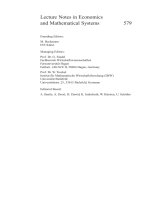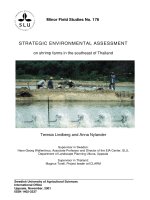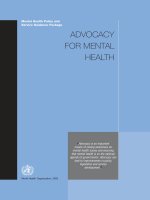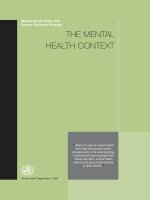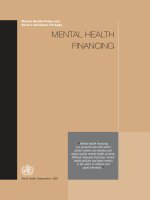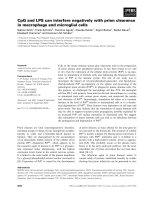Strategic Environmental Assessment In Policy And Sector Reform Conceptual Model And Operational Guidance pdf
Bạn đang xem bản rút gọn của tài liệu. Xem và tải ngay bản đầy đủ của tài liệu tại đây (1.79 MB, 240 trang )
ENVIRONMENT AND DEVELOPMENT
Conceptual Model
and Operational Guidance
Strategic Environmental
Assessment
in Policy and
Sector Reform
Strategic Environmental Assessment
in Policy and Sector Reform
ENVIRONMENT
AND
DEVELOPMENT
A fundamental element of sustainable development is environmental sustain-
ability. Hence, this series was created in 2007 to cover current and emerging issues
in order to promote debate and broaden the understanding of environmental
challenges as integral to achieving equitable and sustained economic growth. The
series will draw on analysis and practical experience from across the World Bank
and from client countries. The manuscripts chosen for publication will be central
to the implementation of the World Bank’s Environment Strategy, and relevant
to the development community, policy makers, and academia. Topics addressed
in this series will include environmental health, natural resources management,
strategic environmental assessment, policy instruments, and environmental
institutions, among others.
Titles in this series:
The Changing Wealth of Nations: Measuring Sustainable Development in the New
Millennium
Convenient Solutions to an Inconvenient Truth: Ecosystem-Based Approaches to
Climate Change
Environmental Flows in Water Resources Policies, Plans, and Projects: Findings and
Recommendations
Environmental Health and Child Survival: Epidemiology, Economics, and
Experiences
International Trade and Climate Change: Economic, Legal, and Institutional
Perspectives
Poverty and the Environment: Understanding Linkages at the Household Level
Strategic Environmental Assessment for Policies: An Instrument for Good Governance
Strategic Environmental Assessment in Policy and Sector Reform: Conceptual Model
and Operational Guidance
World Bank
University of Gothenburg
Swedish University of Agricultural Sciences
Netherlands Commission for Environmental Assessment
Strategic
Environmental
Assessment in Policy
and Sector Reform
Conceptual Model and
Operational Guidance
© 2011 The International Bank for Reconstruction
and Development / The World Bank
1818 H Street NW
Washington DC 20433
Telephone: 202-473-1000
Internet: www.worldbank.org
All rights reserved
1 2 3 4 13 12 11 10
This volume is a collaborative product of the staff of the International Bank for Reconstruction and
Development / The World Bank, the University of Gothenburg, the Swedish University of Agricultural Sciences,
and the Netherlands Commission for Environmental Assessment. The findings, interpretations, and conclusions
expressed in this volume do not necessarily reflect the views of the Executive Directors of The World Bank or the
governments they represent.
The World Bank does not guarantee the accuracy of the data included in this work. The boundaries, colors,
denominations, and other information shown on any map in this work do not imply any judgement on the
part of The World Bank concerning the legal status of any territory or the endorsement or acceptance of such
boundaries.
RIGHTS AND PERMISSIONS
The material in this publication is copyrighted. Copying and/or transmitting portions or all of this work
without permission may be a violation of applicable law. The International Bank for Reconstruction and
Development / The World Bank encourages dissemination of its work and will normally grant permission to
reproduce portions of the work promptly.
For permission to photocopy or reprint any part of this work, please send a request with complete infor-
mation to the Copyright Clearance Center Inc., 222 Rosewood Drive, Danvers, MA 01923, USA; telephone:
978-750-8400; fax: 978-750-4470; Internet: www.copyright.com.
All other queries on rights and licenses, including subsidiary rights, should be addressed to the Office of
the Publisher, The World Bank, 1818 H Street NW, Washington, DC 20433, USA; fax: 202-522-2422; e-mail:
ISBN: 978-0-8213-8559-3
eISBN: 978-0-8213-8560-9
DOI: 10.1596/978-0-8213-8559-3
Library of Congress Cataloging-in-Publication Data has been requested.
Cover photos: Fernando Loayza, World Bank
Cover map: World Bank (Map IBRD 38108, October 2010).
Cover design: Naylor Design
v
ix Acknowledgments
xi Abbreviations
1 Overview
2 The World Bank SEA Pilot Program
3 Main Findings
4 Guidance for Applying SEA in Sector Reform
6 Ways Forward
8 Notes
8 References
CHAPTER 1
9 The World Bank’s Pilot Program on SEA
12 Piloting SEA in Policy and Sector Reform
13 Objectives of the Evaluation
14 The Evaluation Approach
18 Limitations of the Pilot Program and Evaluations
19 Structure of the Report
19 Notes
20 References
CHAPTER 2
23 Influencing Sector Reform for Sustainability
24 The Pilots and Policy SEA Outcomes
38 Enabling and Constraining Factors for Effectiveness of SEA in Policy and
Sector Reform
51 Refining the Conceptual Model of Policy SEA
53 Conclusion
54 Notes
54 References
CHAPTER 3
57 Guidance for Applying SEA in Development Policy and Sector
Reform
57 Preparatory Policy SEA Work
60 Implementing SEA in Policy and Sector Reform
79 Environmental and Social Mainstreaming Beyond Policy SEA
83 Conclusion
CONTENTS
vi CONTENTS
83 Notes
84 References
CHAPTER 4
85 Conclusions and Recommendations for Ways Forward
85 Main Findings of the Evaluation
89 Promoting Policy SEA: A Phased Approach
92 Promoting Policy SEA: Issues to Consider in the Partner Country
Context
96 Promoting Policy SEA: Issues for Consideration by Development
Agencies
99 Conclusion
100 Notes
100 References
Appendixes
103 Appendix A: Summaries of the Policy SEA Pilots
127 Appendix B: Conceptual Analysis and Evaluation Framework for
Institution-Centered Strategic Environmental Assessment
199 Appendix C: Policy SEA Process Methods
205 Appendix D: Summary of International Workshop, “SEA for
Development Cooperation: Taking Stock and Looking Forward”
215 Index
Boxes
13 1.1 Brief Summary of the Policy SEA Pilots
17
1.2 SEA for Development Cooperation: Taking Stock and Looking
Forward
18
1.3 How Can One Generalize from Case Studies?
52
2.1 Contextual Influencing Factors
58
3.1 Rapid Policy SEA
60
3.2 The Need for Multisector Ownership of SEA When the Counterpart
Sector Agency Is Not Strong
64
3.3 Approaches to Situation Assessment in the Sierra Leone SESA and
the WAMSSA
71
3.4 Framing the SEA Work in the Context of Forest Sector Reform
Priorities
72
3.5 Transforming Relationships for Intercultural Dialogue and
Sustainable Development: Las Bambas Mining Project in Peru
74
3.6 Selection of Environmental and Social Priorities: Sierra Leone SESA
Ranking Methodology
76
3.7 Institutional and Capacity Assessment in the Sierra Leone Mining
Sector SESA
82
3.8 Kenya Forests Act SEA Policy Action Matrix
93
4.1 Scaling Up and Threats to Established Authority: The Hubei
Transport Planning Pilot
CONTENTS vii
Figures
15 1.1 The Policy SEA Pilot Program Evaluation Approach
16
1.2 Initial Conceptual Model of Policy SEA: Process Steps, Process
Outcomes, and Objective
29
2.1 Example of a Long-Term Constituency Proposal: The West Africa
Mineral Governance Program Implementation Framework
51
2.2 Outcomes and Influence of Policy SEA
53
2.3 Refined Conceptual Model of Policy SEA: Process Steps, Process
Outcomes, and Objective
62
3.1 Policy SEA Process Steps
66
3.2 Mapping of Key Stakeholders: Hubei Road Transport Planning
SEA Pilot
67
3.3 Stakeholder Interest in and Influence over Decision Making:
WAMSSA Pilot
70
3.4 Interaction with Stakeholders: WAMSSA
137
1 Schematic Representation of I-SEA in Policy Formation
140
2 Conceptual Model of I-SEA: Process Steps, Process Outcomes,
and Objective
160
3 Institutions as Formal and Informal Rules
161
4 Levels in Institutional Analysis
Tables
36 2.1 Policy-Level SEA Outcomes (excluding social learning)
38
2.2 Influence of SEA Pilots on Policy Capacities, Policy Horizons, and
Decision Regimes
43
2.3 Contextual Factors that Constrain or Enable Achievement of Policy
SEA Goals
79
3.1 Snapshot from the Policy Action Matrix Produced in the Kenya
Forests Act Policy SEA
90
4.1 Phased Approach to Scaling Up of SEA in Policy and Sector Reform
(10 years)
172
1 Typology of Problem Situations with Indicated Support Approach
Acknowledgments
Undertaken in the context of the Paris Declaration on Harmonization and
Alignment, this study was a collaborative effort of the Environment Department
of the World Bank, the Environmental Economics Unit at the Department of
Economics of the University of Gothenburg (EEU), the Swedish EIA Centre at
the Swedish University of Agricultural Sciences, and the Netherlands Commission
for Environmental Assessment (NCEA). The team that produced this report
regularly informed the strategic environmental assessment (SEA) Task Team
of the Organisation for Economic Co-operation and Development (OECD)
Development Assistance Committee (DAC) on the progress of the review and
received valuable feedback during Task Team meetings and other jointly organ-
ized events. It is expected that this report will provide guidance for applying SEA
in development cooperation that supports policy and sector reform.
The team that produced this report was made up of Fernando Loayza (task
team leader, World Bank), David Annandale (consultant), Anna Axelsson and
Matthew Cashmore (Swedish EIA Centre, University of Agricultural Sciences),
Anders Ekbom and Daniel Slunge (EEU), Mans Nilsson (consultant), and Rob
Verheem (NCEA). This report is based on the findings of the evaluation of pilots
under the World Bank’s SEA pilot program; the evaluations were undertaken by
David Annandale, Anna Axelsson, Matthew Cashmore, Anders Ekbom, Daniel
Slunge, and evaluators Juan Albarracin-Jordan, Jiri Dusik, Paul Guthiga, Yin
Jian, Wilfred Nyangena, and Ulf Sandstrom. The contribution of Geske Dijkstra,
Sibout Nooteboom, and Ineke Steinhauer to the framework for the evaluation
of pilots is also acknowledged.
The team greatly benefited from the advice of Kulsum Ahmed (World Bank),
Fred Carden (International Development Research Centre, Canada), and Maria
Rosario Partidario (University of Lisbon, Portugal), who were members of
the evaluation’s advisory group. Detailed comments were also provided by
peer reviewers Diji Chandrasekharan (World Bank), Peter Croal (Canadian
International Development Agency and chair of the OECD DAC SEA Task Team),
Richard Damania (World Bank), and Gary McMahon (World Bank). The team
further acknowledges the feedback received from the participants in the meet-
ings and workshops held in Gothenburg (2007 and 2008), Rotterdam (2008),
Washington, D.C. (2009), Geneva (2010), and Utrecht (2010). James Cantrell,
Patricia Katayama, Cindy Fisher, and Nora Ridolfi, all of the World Bank, assisted
in the publication and dissemination of this book. Grace Aguilar, Juliette Guantai,
ix
and Setsuko Masaki, all of the World Bank, provided administrative support
to the team. The work was carried out under the general direction of James
Warren Evans, director, and Michele de Nevers, sector manager, of the World
Bank Environment Department; and as part of the work program of the World
Bank’s Environmental Institutions and Governance Team, led by Kulsum Ahmed.
This report would not have been possible without the collaboration of the
governments and the World Bank’s country offices where the pilot SEAs were
carried out. The task managers of the SEA pilots, all from the World Bank—
Diji Chandrasekharan, Adriana Damianova, Fei Deng, Peter Kristensen, Bryan
Land, and Muthukumara Mani—kindly facilitated data collection, suggested
contacts, and participated in interviews during the evaluation. Stakeholders
from government departments, communities, nongovernmental organizations,
civil society organizations, and the private sector generously provided their
time and knowledge both during the SEA pilots and during the evaluation.
The partners in this evaluation are most grateful to all of the stakeholders for
their spirited participation. This appreciation and gratitude is extended to the
Swedish, Dutch, Norwegian, and Finnish governments for their support of
this evaluation and the World Bank’s SEA pilot program, through trust funds
from the Swedish International Development Cooperation Agency, the Trust
Fund for Environmentally and Socially Sustainable Development, and the Bank
Netherlands Partnership Program.
x ACKNOWLEDGMENTS
Abbreviations
AMGP Africa Mineral Governance Program
CBA cost-benefit analysis
CBO community-based organization
CEA cost-effectiveness analysis
CIDA Canadian International Development Agency
CSO civil society organization
CUA cost-utility analysis
DAC Development Assistance Committee (OECD)
DAP Detailed Area Plan
DIEWRMP Dhaka Integrated Environment and Water Resources
Management Program
DMDP Dhaka Metropolitan Development Plan
ECOWAS Economic Community of West African States
EIA environmental impact assessment
EEU Environmental Economics Unit, Department of Economics,
University of Gothenburg
EITI Extractive Industries Transparency Initiative
HPCD Hubei Provincial Communication Department
HRNP Hubei Road Network Plan
IAD institutions and development framework
IDRC International Development Research Centre
I-SEA institution-centered strategic environmental assessment
J4P Justice for the Poor
KFS Kenya Forest Service
OECD Organisation for Economic Co-operation and Development
MSR mineral sector review
MTAP Mining Technical Assistance Project
NACEF National Commission for Environment and Forestry
NCEA Netherlands Commission for Environmental Assessment
NGO nongovernmental organization
PAM policy action matrix
PEI Poverty-Environment Initiative
PSIR pressure-state-impact-response
RAC Resource Assessment Commission (Australia)
RAJUK Capital Development Authority (Dhaka)
xi
SEA strategic environmental assessment
SESA strategic environmental and social assessment
UNDP United Nations Development Programme
UNEP United Nations Environment Programme
WAEMU West African Economic and Monetary Union
WAMGP West Africa Mineral Governance Program
WAMSSA West Africa Minerals Sector Strategic Assessment
xii ABBREVIATIONS
1
Overview
AROUND THE WORLD, it is increasingly being recognized that for sustain-
ability goals to be reached, efforts need to go beyond complying with standards
and mitigating adverse impacts, to identifying environmental sustainability as
an objective of the development process. This approach requires the integration
of environmental, sustainability, and climate change considerations into policy
and sector reform.
Because sector reform brings about significant policy change involving adjust-
ments in laws, policies, regulations, and institutions, it is a sensitive political
process often driven by strong economic interests. Policy makers are subject to
a number of political pressures that originate in vested interests. The weaker the
institutional and governance framework in which sector reform is formulated and
implemented, the greater the risk of regulatory capture. The recommendations of
environmental assessment are often of little relevance unless there are constituen-
cies that support them and have sufficient political power to make their voices
heard in the policy process. While strong constituencies are important during the
design of sector reform, they are even more important during implementation.
It follows that effective environmental assessment in policy and sector reform
requires strong constituencies backing up recommendations, a system to hold
policy makers accountable for their decisions, and institutions that can balance
competing and, sometimes, conflicting interests.
2 STRATEGIC ENVIRONMENTAL ASSESSMENT IN POLICY AND SECTOR REFORM
Acknowledging the intrinsically political nature of sector reform, and in
response to a mandate for strengthening strategic environmental assessment
(SEA)
1
in its activities,
2
in the mid-2000s the World Bank embarked on a testing
program for applying SEA at the policy level. Building on experience accumu-
lated in sector reform in middle-income countries, the World Bank proposed
an approach known as institution-centered SEA for incorporating environmental
considerations in policy formulation (World Bank 2005, 2008). This proposed
approach coincided with the development of the Organisation for Economic
Co-operation and Development (OECD) Development Assistance Committee
SEA Task Team’s Applying Strategic Environmental Assessment: Good Practice
Guidance for Development Co-operation (OECD DAC 2006), which describes
SEA as a family of approaches using a variety of tools, rather than a fixed, single,
and prescriptive approach. It acknowledges that SEA applied at the policy level
requires a particular focus on the political, institutional, and governance context
underlying decision-making processes.
The World Bank SEA Pilot Program
The World Bank established a pilot program to test and promote SEA applying
institution-centered SEA approaches in policy and sector reform beginning in
2005. The main objectives of the program have been to test and validate policy-
based SEA in different sectors, countries, and regions; to draw lessons on the
effectiveness of this approach; and to yield tools and operational guidance that
could be useful in applying SEA in policy and sector reform.
There are two components to the pilot program. The first has provided grants
and/or specialized assistance to support eight SEA pilots linked to World Bank
activities. Six of these pilots were completed and evaluated:
■
Strategic Environmental Assessment of the Kenya Forests Act 2005
■
Sierra Leone Mining Sector Reform Strategic Environmental and Social
Assessment (SESA)
■
Dhaka Metropolitan Development Plan Strategic Environmental Assessment
■
Strategic Environmental Assessment for the Hubei Road Network Plan
(2002–2020)
■
West Africa Minerals Sector Strategic Assessment (WAMSSA)
■
Rapid Integrated Strategic Environmental and Social Assessment (SESA) of
Malawi Mineral Sector Reform
The second component of the SEA pilot program consisted of an evaluation of
the pilots, conducted in partnership with the Environmental Economics Unit at
the University of Gothenburg, the Swedish EIA Centre at the Swedish University
of Agricultural Sciences, and the Netherlands Commission for Environmental
Assessment. This book summarizes the main findings and results of this evaluation.
OVERVIEW 3
Main Findings
The lessons drawn from the pilots suggest that SEA can, under conducive condi-
tions, contribute to improved formulation and implementation of sector reform.
Largely, this contribution stems from the ability of the pilots to call attention to
priority environmental and social issues affecting stakeholders. The evaluation
also confirmed the importance of strengthening constituencies, as the pilots
opened up participation in sector-reform dialogues to previously sidelined or
weakly organized stakeholders. For example, in one of the most promising SEA
pilots—WAMSSA, which focused on mining reform in the Mano River Union
countries—stakeholders prioritized lack of transparency and weak social account-
ability linked to mineral resources exploitation as the most critical issue affecting
sustainable development in the mining sector. The WAMSSA policy dialogue
involved 10 mining communities in three countries, civil society organizations
(CSOs) and nongovernmental organizations (NGOs), private mining companies,
and government mining sector authorities. This dialogue is expected to continue
during mining sector reform through a multistakeholder framework, which was
recommended by the stakeholders themselves and later adopted by the countries
as the social accountability mechanism for the World Bank’s major program in
support of mining sector reform in the Mano River Union.
In addition, it was found that ownership, capacity, and trust are necessary condi-
tions for effective environmental mainstreaming at the policy level. In particular,
strong evidence was found that SEA has positive outcomes only if it promotes
ownership of the policy SEA process by governments, CSOs, and local communi-
ties. The evaluation confirmed that country ownership has several dimensions.
Because government ownership involves a mandate to control the reform and
accountability for results, when national agencies are put in charge of designing
policies, they are equipped to deliver much more powerful measures than those
that the World Bank or other agencies would be able to induce. It is important to
note, however, that when weak sector ministries take ownership of SEA, there is a
risk of regulatory capture and associated rent seeking. The WAMSSA pilot showed
that arrangements such as multistakeholder frameworks can guard against this
eventuality. Another dimension of ownership is linked to civil society and to
potentially affected stakeholders. With well-designed institutional support and
multistakeholder frameworks for addressing policy and development decisions
in sector reform, SEA can help to reconcile different interests and to address
regulatory capture by enhancing transparency and social accountability.
Another important finding emanating from the evaluation is that long-term
constituency building is needed. SEA is but a small and bounded intervention in the
continuous process of policy making, and so positive outcomes from the pilots could
be short-lived. To sustain outcomes over the longer term, it is necessary to build
constituencies that can sustain policy influence and institutional changes, which
4 STRATEGIC ENVIRONMENTAL ASSESSMENT IN POLICY AND SECTOR REFORM
takes a long time to realize. Constituencies that can demand accountability with
regard to environmental and social priorities need to be strengthened. Achieving this
goal requires trust building and a common perception of problems. Under the right
conditions, as stakeholders start to deal with the complex problems and responses
to sustainable development issues and to share policy dilemmas and trade-offs that
emerge, a common perception of problems and trust in each others’ intentions may
surface. As a corollary, the evaluation showed that when constituency building was
weak in the pilots, the take-up of SEA recommendations was limited.
A final finding is that contextual factors are of overriding importance in deter-
mining whether the main benefits of policy SEA are attained. In some cases, these
factors may be aligned in such a way that pursuing policy SEA is not mean-
ingful. This can happen when—as in the case of the Sierra Leone pilot—a newly
elected government decides to slow down reform processes initiated by a previous
administration. In all cases, however, preparation and planning must make sure to
adapt and adjust the SEA process in view of these factors. In addition, windows of
opportunity that close may open over time. In Sierra Leone, for example, interest
in mining reform has renewed. SEA may at this point have an opportunity to
influence sector reform as long as there are constituencies that can take up the
now three-year-old recommendations.
A lesson related to the issues of ownership and constituency building is that
the potential benefits of policy SEA must be clearly articulated. Developers of SEA
must recognize that incumbent actors have certain interests when engaging
in SEA activities. Their participation will occur when the benefits of engaging
are greater than the risks and costs. Policy-based SEA must first and foremost
be understood as a strategic decision support process that will enable govern-
ments to engage in better policy making, and not merely as an environmental
safeguard. Speaking directly to the development priorities of the country, SEA
at the policy level not only works toward improving policy making from an
environmental mainstreaming perspective, but also supports better planning and
policy making from an overarching development point of view. As sector review
analyzes the potential economic and growth impact of sector reform, SEA could
offer a complementary analysis that explores the economic and growth implica-
tions of environmental and social priorities. This perspective on SEA makes it
much easier to establish country ownership.
Guidance for Applying SEA in Sector Reform
A major purpose of the pilot program and the evaluation was the development
of operational guidance that policy makers, CSOs, NGOs, and SEA practitioners
could use for applying SEA in policy and sector reform. Despite the fact that
sector reform is complex and nonlinear, and that SEA is a time-bounded process,
OVERVIEW 5
the evaluation suggests that effective SEA at the policy level could follow three
stages, as follows:
1. Preparatory work for policy SEA. Before implementation of policy SEA can
begin, there is a need to understand the context within which it will take place.
Various questions need to be asked to ensure that the goals and intentions of
the specific SEA process are understood by the major stakeholders. The most
important questions relate to issues, initiatives, or questions to be addressed;
the scale of the process; and the assessment of windows of opportunity. As
clearly shown by the pilot SEA in Dhaka, a reluctant lead agency can set back
the general development of the approach. As a general rule, sector agencies
should lead policy SEA.
2. Implementing policy SEA. This stage involves the following steps:
Situation analysis and priority setting. SEA at the policy level starts with a
situation assessment that accounts for the main environmental and social
issues prevailing in a region or associated with a sector; the goal is to inform
deliberations on priorities by stakeholders. Stakeholders are invited to react
to the situation analysis; raise specific and relevant environmental and social
concerns; and choose the SEA priorities. The choosing of SEA priorities by
stakeholders is critical because it opens up the policy process to their influence.
On the one hand, SEA priorities reflect the concerns and preferences of
stakeholders, who now have a strong incentive for constituency building or
strengthening. On the other hand, SEA priorities are a demand from stake-
holders to policy makers to give the reform a specific environmental and social
direction and thus sow the seeds for social accountability. Accordingly, special
care should be taken to ensure that the voices of the vulnerable and weak in
society are effectively heard in priority setting.
Institutional, capacity, and political economy assessment. The next stage in
applying SEA in policy and sector reform is to assess the extent to which
existing systems have been able to manage the chosen priorities. A first step
is often a thorough review of the policy, institutional, legal, and regulatory
frameworks, and of the existing capacities associated with the management of
environmental and social priorities. This is followed by an assessment of the
effectiveness of these frameworks and capacities for addressing the priorities,
which facilitates the identification of institutional weaknesses and capacity
gaps. This analysis is complemented by an assessment of the effect that sector
reform may have on the identified weaknesses and gaps. The analysis requires
considering the potential reactions of stakeholders and the potential conflicts
that may adversely affect the reform. Finally, these assessments are validated by
the stakeholders to expose them to the complexities of sector reform, and to
call attention to the need for finding common ground in order to prevent or
manage potential conflicts.
6 STRATEGIC ENVIRONMENTAL ASSESSMENT IN POLICY AND SECTOR REFORM
Recommendations. Finally, policy SEA should formulate specific policy,
institutional, legal, regulatory, and capacity-building recommendations for
overcoming the weaknesses and gaps, and for managing the political economy
constraints, determined during the assessment. Validation of the recommen-
dations by stakeholders further strengthens constituencies because it enhances
ownership and encourages stakeholders’ participation in follow-up and
monitoring. Ultimately, this step promotes greater accountability on the part
of policy makers.
3. Environmental and social mainstreaming beyond policy SEA. After completion
of the policy SEA report, certain follow-on interventions should be established
to ensure that the recommendations are implemented and that environmental
and social mainstreaming becomes a continuous process. At a minimum, stake-
holders should be informed about the results of the SEA through mechanisms
appropriate for different audiences. To the extent possible, dissemination
and discussion of the results by the media should also be promoted. Any
monitoring and evaluation framework should be designed as a continuation
of the multistakeholder dialogue established during the SEA. At this point, the
dialogue should allow for reflection on what was or was not achieved by the
SEA and the sector reform.
Ways Forward
SEA can be an effective approach for assisting with the implementation of policy
and sector reforms that foster sustainable development. Therefore, the main
recommendation of this report is to move forward with further testing and a staged
scaling up of SEA at the policy level. It is suggested that scaling up be undertaken
in three phases over approximately 10 years. The main expected outcome is this:
better policy making and successful environmental and social mainstreaming in
selected countries as a result of greater capacity for undertaking SEA in policy and
sector reform; increase in trust among stakeholders; and strengthened country
ownership. The expected development impacts would be contribution to sustain-
able economic growth, mitigation of and adaptation to climate change, and
improvement in environmental and social management of key sectors in selected
countries.
The proposed scaling up would focus on promoting the following:
■
Country ownership. There is strong evidence from the evaluation of the pilots
that unless country ownership is ensured, SEA of policy and sector reform
is unlikely to be effective. Therefore, the proposed scaling up suggests that
donors, the World Bank, and other multilateral institutions should encourage
partner countries to undertake SEA for informing policy making. However,
OVERVIEW 7
as has happened with environmental impact assessment, financial support
to client countries would be required during the first stage of testing and
experimentation, until SEA becomes ingrained in the regular process of sector
planning and policy making. It is suggested that a policy SEA fund be estab-
lished to provide low-income countries with grants, specialized advice, and
technical assistance to facilitate their undertaking SEA of policy and sector
reform.
■
Capacity building on policy SEA in sectors critical for economic growth and
climate change. The evaluation also provides ample evidence that SEA effec-
tiveness is constrained by the punctuated, short-lived nature of sector-reform
design when SEA typically takes place. In this new phase of piloting policy SEA,
a more strategic approach is consequently suggested. Capacity building should
focus on raising awareness of SEA as an approach for improving planning and
policy making by supporting the accumulation of SEA skills in key sectors of
the economy at the level of public agencies, consultants, and civil society. The
idea is to set in motion a process that ensures that proposed institutional,
legal, regulatory, capacity, and policy adjustments originating in individual
SEAs reinforce each other, thereby creating a virtuous cycle of environmental,
social, and climate change mainstreaming. Countries could participate in the
proposed program on a self-selection basis provided that they are interested
in applying SEA in sectors critical for economic growth and for mitigation of
and adaptation to climate change.
■
A system of incentives that rewards successful reform and gradual environmental,
social, and climate change mainstreaming. The evaluation has also shown that
unless there are incentives for sustaining the mainstreaming effort and strong
constituencies that demand it, the process may be derailed or thwarted by
vested interests.
■
An alliance of donors and partner countries for environmental, social, and
climate change mainstreaming. In the context of the Paris Declaration on Aid
Effectiveness, the proposed program aims at seizing the window of opportu-
nity that seems to be opening for fostering policy SEA with the development
of the World Bank Group’s New Environment Strategy, the scaling up of the
Poverty-Environment Initiative (PEI) of the United Nations Development
Programme and the United Nations Environment Programme, and environ-
mental and climate change mainstreaming initiatives being undertaken by
other multilateral and bilateral development agencies. It seems that the time
is ripe for the establishment of a broad environmental mainstreaming alliance,
which would clarify the roles and niches of the different interested parties. The
World Bank could add its more specialized experience in sector reform to a
potentially influential alliance. The alliance would help partner countries learn
from one another’s experiences in applying SEA in policy and sector reform
8 STRATEGIC ENVIRONMENTAL ASSESSMENT IN POLICY AND SECTOR REFORM
to address common and global challenges such as climate change. The result
would be to render SEA implementation globally more efficient.
If this proposal for scaling up is not fully realized, SEA could still make an
important contribution to enhancing sector reform. The evidence provided by
this evaluation suggests that donors and partner countries should join efforts to
foster SEA in policy and sector reform under the following conditions:
■
Country ownership is ensured
■
SEA is undertaken along with sector-reform design and not as an isolated
exercise
■
Follow-on activities recommended by the SEA can be supported during sector-
reform implementation
Notes
1 SEA describes analytical and participatory approaches that aim to integrate envi-
ronmental considerations into policies, plans, and programs and to evaluate the
interlinkages with economic and social considerations (OECD DAC 2006, 30).
2 This mandate was provided by the Bank’s Environment Strategy of 2001.
References
OECD DAC (Organisation for Economic Co-operation and Development, Development
Assistance Committee). 2006. Applying Strategic Environmental Assessment: Good
Practice Guidance for Development Co-operation. Paris: OECD Publishing.
World Bank. 2005. Integrating Environmental Considerations in Policy Formulation: Lessons
from Policy-Based SEA Experience. Report 32783. Washington, DC: World Bank.
World Bank. 2008. Environmental Sustainability: An Evaluation of World Bank Group
Support. Independent Evaluation Group. Washington, DC: World Bank.
9
The World Bank’s Pilot
Program on SEA
ENVIRONMENTAL DEGRADATION CONTINUES to be a consistent
concern around the world. In addition, converging challenges associated with
surging food prices, global climate change, and species extinction have made it
clear that current economic development trends are unsustainable.
The predominant approach to dealing with environmental and climate change
problems has been to treat them as unwanted side effects of economic develop-
ment. This approach has worked to some extent where it has been possible to
effectively regulate commercial and domestic activities. However, in most devel-
oping countries, administrative infrastructure has not been able to keep pace with
economic activity, and so ecosystems are suffering.
There is growing recognition that for sustainability goals to be reached, efforts
need to go beyond complying with standards and mitigating adverse impacts, to
gradually decoupling environmental degradation from economic growth. This
effort requires mainstreaming environmental, sustainability, and climate change
CHAPTER 1
In 2005, the World Bank established the Pilot Program on Institution-Centered SEA
(I-SEA) to test a strategic environmental assessment (SEA) approach centered on institu-
tions and governance rather than on impact assessment. As the pilots were evaluated, it
became clear that many of the observations and conclusions derived from the six pilot
studies were applicable to SEA of policy and sector reform. Consequently, the terms “SEA
at the policy level,” “policy SEA,” and “I-SEA” are used interchangeably in this report.
10 STRATEGIC ENVIRONMENTAL ASSESSMENT IN POLICY AND SECTOR REFORM
considerations into policy and sector reform.
1
This idea has been recognized at
a high level, for example, in Millennium Development Goal 7, which requires
countries to “integrate the principles of sustainable development into country
policies and programs and reverse the loss of environmental resources” (http://
www. un.org/millenniumgoals/environ.shtml).
Environmental mainstreaming requires consideration of the environment in
the earliest stages of the decision-making cycle, when development challenges
as well as proposed interventions are framed. In this conception, environmental
issues are thought of as a cross-cutting dimension of development. Within
European and national policy debates, environmental mainstreaming at the
policy level is more often referred to as environmental policy integration. Over
the last decade, substantial experience has been gained by both governments and
the research community in how to promote such integration, particularly in the
making of national and European policy.
2
Integration of environmental concerns into strategic decision making requires
an understanding of the complexities of policy making. Public policies are
made by governments within the institutional
3
framework of the public sector.
Consequently, attempts to take account of the environment in the making of
economic development decisions require attending to the sometimes opaque
and messy areas of governance and institutional reform.
There are numerous tools or approaches that can be used to integrate envi-
ronmental concerns into strategic decision making,
4
and one of the most
promising is strategic environmental assessment (SEA). SEA has its roots in
environmental impact assessment (EIA) of development projects. In the late
1980s, environmental assessment practitioners began to turn their attention to
the environmental impacts of policies, plans, and programs. Many countries
began to experiment with the application of strategic environmental assessment
to plans and programs, and some jurisdictions produced SEA policies, laws, or
regulations (Dalal-Clayton and Sadler 2005). In Europe, this new development
was given significant impetus with the coming into law of the European Directive
on SEA.
5
International development agencies also began to test SEA in the 1990s,
with the World Bank leading the way with a range of sector and regional envi-
ronmental assessment initiatives.
6
Environmental assessment of policies began to take hold around the turn
of the new millennium. By that time, 30 years of experience with project-level
EIA, and with other environmental “safeguarding” approaches to environmental
improvement such as end-of-pipe pollution control, had taught that treating
the symptoms of existing pollution was not helping enough in the struggle
to foster more environmentally benign or sustainable development. Instead,
the idea began to grow that the forces driving environmental damage could be
THE WORLD BANK’S PILOT PROGRAM ON SEA 11
most effectively addressed by integrating environmental considerations into the
design and adoption of policies in all sectors. The argument was that cumulative
environmental change, environmental opportunities, and potential interactions
between different sectors could best be considered upstream in the selection and
design of development and sector policies, rather than downstream through
project management and end-of-pipe solutions.
7
This was a major conclusion
of the World Summit on Sustainable Development in Johannesburg in 2002, and
the view is also reflected in the Millennium Development Goals and the Paris
Declaration on Aid Effectiveness. The corollary of this new way of thinking is
that economic efficiency can be improved if environmental and social issues
are considered alongside traditional economic concerns when new policies and
strategic plans are developed.
Because of this realization, national governments and development agencies
have begun to experiment with approaches that attempt to integrate environmental
concerns into new and reformed policies. In international development, most
notable has been the initiation of environmental mainstreaming programs by
agencies such as multilateral development banks, the United Nations Development
Programme (UNDP) and United Nations Environment Programme (UNEP), and
others. For example, the UNDP-UNEP Poverty-Environment Initiative has done
much to promote the idea of environmental mainstreaming in national and sector
development policy, plans, and budgets.
8
Similarly, the multiagency network
known as the Poverty Environment Partnership is attempting to mainstream
environmental concerns into development aid in support of national and sector
development planning.
9
Another notable initiative from the early 2000s was the Organisation for
Economic Co-operation and Development (OECD) Development Assistance
Committee’s SEA Task Team. This was established by the donor community to
promote the development and harmonization of SEA approaches, and is made
up of most donors and a number of leading nongovernmental organizations,
consultants, and academics with an interest in SEA for development cooperation.
In 2006, the task team produced Applying Strategic Environmental Assessment:
Good Practice Guidance for Development Co-operation (OECD DAC 2006), which
has been followed by four specific advisory notes. These were a timely response
to the 2005 Paris Declaration on Aid Effectiveness, which calls upon donors
and partners to work together to “develop and apply common approaches for
strategic environmental assessment at sector and national levels” (OECD 2005).
The OECD DAC SEA Guidance describes SEA as a “family of approaches
which use a variety of tools, rather than a fixed, single and prescriptive approach.”
It acknowledges that “SEA applied at the policy level requires a particular focus
on the political, institutional and governance context underlying decision making


